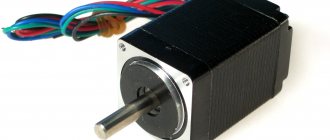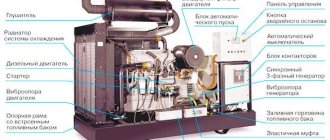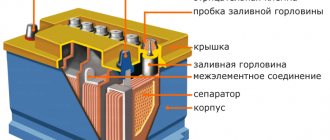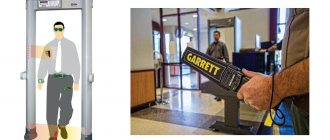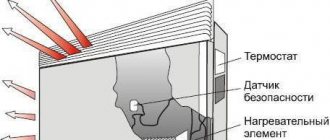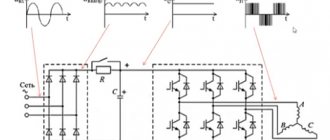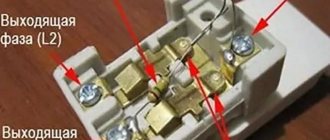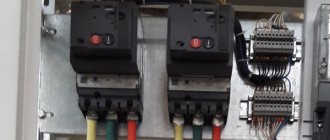An electric convector is a heating device that heats a room through convection. Unlike the same fan heaters, where warm air is forcibly blown out and distributed throughout the room, an electric convector uses the natural movement of air flows that occurs due to temperature differences. Thanks to this, the device operates silently.
The convector device is not complicated. The device consists of the following parts:
- frame;
- radiator screen;
- a heating element;
- temperature sensor;
- thermostat;
- on-off block.
Main varieties
Various energy sources can be used to operate convection heating in a private home, but most household devices of this type are equipped with electric heaters. There are also gas convectors that run on gas. The great popularity of electric models for heating rooms is explained by their compact dimensions. In cases where convective heating plays the role of the main one (which often happens in country houses and dachas), it is more profitable to use gas modifications, because gas is much cheaper.
Based on the installation method, convectors are:
- Floor-standing
. Designed for floor placement. Some models are equipped with special wheels for mobility. In other cases, a rigid installation is used, without the possibility of movement. - Wall mounted
. They are hung on the walls of the room, for which the product kit includes the appropriate fasteners. - Built into the floor or baseboard. This installation principle allows you to save living space.
Frame
Most often, steel is used for the manufacture of modern convectors. The design of the housing can be very diverse, so there are usually no problems with choosing a heater for a specific style of room. There are special fastenings (brackets) on the body of wall-mounted modifications: they make it possible to remove the device from time to time for maintenance.
In some cases, the protective steel box of the convector is equipped with adjustable blinds on the sides: by changing their angle, you can adjust the direction of air flow. This design solution allows for volumetric distribution of heat in the room, which makes its heating more uniform. To avoid underheating, when choosing a convector, it is recommended to leave some power reserve (especially if it is installed in a corner room).
A heating element
Electric convectors are equipped with various heating elements. The most inexpensive solution is steel products, found in the cheapest appliances. The high temperature of the heating coil (up to +160 degrees) allows the room to quickly warm up. However, spirals of this type have a low degree of safety: phenomena such as the accumulation of dust or accidentally ingress of water can cause the device to catch fire. The popularity of spiral convectors is explained, first of all, by their low cost. Some manufacturers additionally equip the device housing with special fans, which, in combination with a high-temperature coil, increases the heating intensity.
More expensive models are equipped with safe low-temperature coils that heat up only to +100 degrees. Elements of this type have the form of dissipative radiators made of aluminum with a built-in steel pipe. A special heating filament is located inside this tube. Thanks to the aluminum housing, heating efficiency is noticeably increased. In some models, instead of one, two tubes are used, which allows you to adjust the operation of the heating block.
The different degrees of expansion exhibited by aluminum and steel provoke a gradual decrease in the reliability of the connection between the heating tube and the housing. As a result, this can lead to a complete breakdown of the connection between them. As a result, there is a danger of local overheating of the tube and damage to the heating element. Manufacturers of convection equipment are constantly searching for a solution to this problem.
RX-Silence heating devices, developed and patented by NOIROT (France), are particularly unique. The innovative design of these convector boilers lies in the complete tightness of the silumin body, where magnesium powder is used to seal the nichrome heating filament. The expansion coefficient of the materials used has very similar values, which makes it possible to significantly reduce energy consumption and increase the service life of the convector to 15-17 years.
Device
An electric convector is a metal rectangular body, in the lower part of which there is an electric heating device (TEH) and an air intake grille, and in the upper part there is an air outlet grille. Additionally, the heater is equipped with a thermostat, which allows you to set the desired air temperature. Due to the absence of moving parts, the convector operates absolutely silently, which is especially important when using the heater in a bedroom or children's room. And splash protection allows them to be used in damp areas, such as bathrooms.
Convector heating control unit
The simplest version of the control unit for convection heating is a thermostat installed inside the heater body. Thermostats are divided into electromechanical and electronic. Electromechanical devices are cheaper, which affects their operating accuracy (the error sometimes reaches 2C0). It is also worth highlighting the noise that occurs from the clicks of the bimetallic sensor when the device is turned on. To set the required temperature regime, electromechanical models have a knob marked with the conditional values of the convector power.
Electronic thermostats are more accurate: their error rarely exceeds 0.1 C0. In addition, convectors of this type are completely silent. A number of models make it possible to program the electronic control unit to enable various operating modes and power, depending on the time of day and day of the week. At the same time, electronic thermostats have the function of remote control of the heating element using an external control device.
As a result, it becomes possible to monitor the operation of a significant number of heaters located in different parts of the home. The convector heating system unit allows the use of built-in operating mode programs separately for each room, or for the entire house in the complex. The French manufacturer NOIROT and the German corporation Siemens are leaders in the market of “intelligent” convectors. Their products provide the ability to control the temperature remotely via phone. This allows you to warm up your home well before your arrival.
Electric heater power calculation
It is important to choose a convection radiator of suitable power. If it is not enough, the room will not warm up, even if the device runs constantly. Taking a convector “with a reserve” is also not a good idea - due to excess power, the room will be too hot and the air will be dry.
There are several basic ways to calculate the required power of a conventional heater:
- by room area;
- by room volume.
In addition, an electric convector can be used as an additional heat source at home or in the office.
Based on the area of the room
This is the fastest way to find out which convector is right for you. The dimensions of the room are not difficult to calculate or estimate at least approximately. But the method is not accurate, so it requires corrections. The general formula looks like this:
0.1 kW per square meter of area
For example, for a room of 12 square meters you need a device with a power of about 1.2 kW.
This calculation is only suitable for standard houses with a ceiling height of about 2.5 m with one door and one window. If the house has a non-standard layout, size and location of windows, the result obtained should definitely be adjusted or a more accurate method should be used.
By room volume
To use a more accurate formula, you must first calculate the volume of the room. To do this, you need to measure the room and multiply its height, length and width. The resulting value is the volume of the room in cubic meters. The formula for the appropriate power of the heating device looks like this:
0.04 kW per cubic meter of volume
For example, if you take the same standard room with an area of 12 sq.m. with a ceiling height of 2.5 m, its volume will be equal to 30 cubic meters. Multiplying by 0.04 kW/h, we obtain the required convector power of 1.2 kW. However, if the height of the room is 3 m, you will need a device with a capacity of 1.45 kW/h for heating.
But this formula also needs clarification. If the room is corner or cold due to the basement below, and also has more than one window, it is worth multiplying the result by a factor of 1.1. And vice versa: if the room has plastic double-glazed windows and good insulation, it is worth multiplying the calculated value by 0.8.
Main settings
Having figured out what convector heating is, you should arm yourself with general information about its technical characteristics. The power of electric convectors is in the range of 0.8 -3 kW, weight - from 3 to 9 kilograms.
Electric convectors currently available for sale are divided into three groups:
- High (450-670 mm).
- Medium (up to 330 mm).
- Narrow (for skirting boards), 140-200 mm high.
Due to their parameters, high-type heaters are able to provide a significant level of convection. Skirting models are equipped with less powerful heating elements. To maintain the proper level of efficiency, they are given a large length (up to 2.5 m).
Principle of operation
As the name implies, an electric convector works by air convection. It is known that cold air is much heavier than warm air, so heated air rises and, when cooled, falls down. This natural circulation of air is convection.
Electric convector with mechanical thermostat Timberk Islandia E3 M
So, cold air enters the device through the lower air intake grille of the convector. Heated by the heating element, it comes out of the device body and rises up. Having cooled down after some time, this air ends up in the lower part of the room and again enters the convector.
Thanks to this principle of operation, electric convectors provide very fast - just a few minutes - and uniform heating of the room. The operating temperature of the heater is low - about 40-45°C, so it is impossible to get burned on it.
Electric wall convectors Termiya EVNA - 1.5/230С2(tss)
Gas convectors
Along with electric convectors, gas-powered appliances with a very similar operating principle are also produced. In this case, gas burners are used instead of spirals to operate the devices. They look like special chambers, the walls of which, as they heat up, transfer heat to the battery. Heating of the surrounding space is carried out directly by the radiator.
Pros and cons of gas convector heating:
- Gas devices do not use complex electronic controls.
- The cost of gas is an order of magnitude cheaper than electricity, so it takes less money to heat your home.
- The complexity of their installation and increased operational requirements (for example, the presence of a chimney) limits the scope of use of gas convectors exclusively to the private sector.
Installation in a private house
The ease of installation of electric convectors allows you to implement this procedure yourself.
Before you make convector heating with your own hands, you need to prepare the following tools:
- Hammer.
- Screwdriver.
- Hammer.
- Level.
A wall-mounted electric convector is installed in the following sequence of operations:
- Assembling the device, during which it is necessary to secure all the brackets to the body.
- Fitting the structure to the wall surface: it must be leveled. During this, marks are made at the location of the brackets.
- The brackets must be removed from the panel and attached one by one to the applied markings. This makes it possible to mark points for drilling holes for fasteners.
- Using a hammer drill, holes are made in the marked places.
- Using a hammer, carefully hammer the dowels into the base.
- To screw the brackets, use a screwdriver or screwdriver.
- The instrument panel is hung on well-fixed brackets.
- To start operating the convector, it must be connected to the network.
When using electrical appliances, it is important to understand that such convector heating of the house will significantly increase the load on the network, so you should calculate in advance whether the old wiring will withstand this. To ensure heating safety, it is recommended to equip devices of this type with separate cable lines. https://www.youtube.com/embed/WZnvggq6oWI
